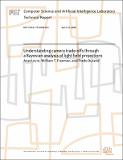Understanding camera trade-offs through a Bayesian analysis of light field projections
Author(s)
Levin, Anat; Freeman, William T.; Durand, Fredo
DownloadMIT-CSAIL-TR-2008-021.pdf (795.7Kb)
Additional downloads
Other Contributors
Vision
Advisor
William Freeman
Metadata
Show full item recordAbstract
Computer vision has traditionally focused on extracting structure,such as depth, from images acquired using thin-lens or pinhole optics. The development of computational imaging is broadening this scope; a variety of unconventional cameras do not directly capture a traditional image anymore, but instead require the joint reconstruction of structure and image information. For example, recent coded aperture designs have been optimized to facilitate the joint reconstruction of depth and intensity. The breadth of imaging designs requires new tools to understand the tradeoffs implied by different strategies.This paper introduces a unified framework for analyzing computational imagingapproaches. Each sensor element is modeled as an inner product over the 4D light field. The imaging task is then posed as Bayesian inference: given the observed noisy light field projections and a new prior on light field signals, estimatethe original light field. Under common imaging conditions, we compare the performance of various camera designs using 2D light field simulations. This framework allows us to better understand the tradeoffs of each camera type andanalyze their limitations.
Date issued
2008-04-16Other identifiers
MIT-CSAIL-TR-2008-021